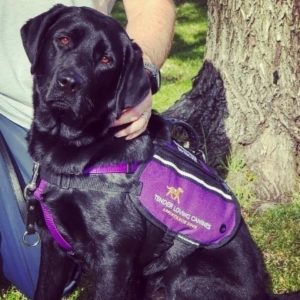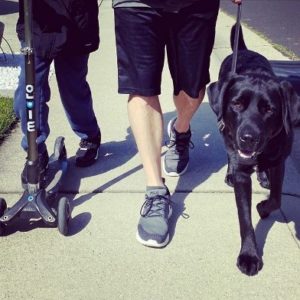[This story was written for the blog and first appeared in the NODCC’s August newsletter.]
by Chris Tompkins
On January 31, 2020, I brought home a service dog (Chance) for my 11-year old son who has hypoplasia of the corpus callosum (HCC), visual impairments, neurodevelopment delays, and falls within the autism spectrum. This post summarizes my family’s journey in welcoming a service dog into the family in hopes that others will find it informative and helpful.
The Background: My wife and I love Labrador Retrievers and began our lives together “parenting” two lab dogs even before we thought about having kids. Once we decided to have children, I was comfortable with the temperament and gentle nature of our furry family members and knew they would learn to love our children. When our son was born, we noticed early on that he had delays. He was formally diagnosed with HCC at 13 months old. As our son grew, we noticed our chocolate lab was a little more receptive to our son and would try to comfort him during times of behavioral issues, while our yellow lab would just leave the room. My wife and I always thought our chocolate lab would have been a great service dog, which put the idea in our heads that if an opportunity presented itself in the future, we would look into how a service dog might be able to assist our son in his goal for independence.

Chance joined the Tompkins family in January 2020.
The Application Process Begins: TLC uses a training program called POOCH. The dogs are trained in prisons by incarcerated trainers who are trained and supervised by TLC staff members. The dogs are trained to perform baseline cues/skills. Once the dog is matched with a client, the incarcerated trainers continue to train the dogs on custom assistive tasks which are cues/skills designed to assist the client in preparation for graduation and home placement. We applied to TLC online and had a follow-up telephone interview to discuss our son’s needs for a service dog. During the phone interview, I was amazed to learn about the different ways a service dog can assist an individual with autism. To start the eligibility process, the phone interview focused on identifying at least four ways in which a service dog would benefit our son. The four needs we identified were: 1) developing independence; 2) socialization; 3) mobility; and 4) sleep issues (I lay on my son’s floor every night for him to fall asleep).
 The Approval Steps, Form, and Training Process: To our delight, we qualified and started the process to be approved and matched with a service dog. I jokingly tell friends that it was easier to purchase a home than pass the rigorous checks to be approved for a service dog, and in some instances, it is true. Items we were required to submit for review include an application, pay stubs, criminal background check, proof of residency, medical verification from our pediatrician, and character letters of support from friends and family members. I also completed a virtual meeting and a one-on-one interview with a trainer at our house to ensure the safety of our residence for a service dog. After completing all the above, we were approved to be matched with a service dog. Our son was matched with “Chance,” a 2 ½ year old male black Labrador Retriever. We were ecstatic! Once we were matched, the placement process consisted of a three-week online training and then a one-week, in-person, hands-on training with Chance for him to be placed in our home. The online training was a good training to give a baseline understanding of service dogs and their capabilities, training methods, feeding, what to do and what not to do, as well as identifying behavioral issues and how to address them.
The Approval Steps, Form, and Training Process: To our delight, we qualified and started the process to be approved and matched with a service dog. I jokingly tell friends that it was easier to purchase a home than pass the rigorous checks to be approved for a service dog, and in some instances, it is true. Items we were required to submit for review include an application, pay stubs, criminal background check, proof of residency, medical verification from our pediatrician, and character letters of support from friends and family members. I also completed a virtual meeting and a one-on-one interview with a trainer at our house to ensure the safety of our residence for a service dog. After completing all the above, we were approved to be matched with a service dog. Our son was matched with “Chance,” a 2 ½ year old male black Labrador Retriever. We were ecstatic! Once we were matched, the placement process consisted of a three-week online training and then a one-week, in-person, hands-on training with Chance for him to be placed in our home. The online training was a good training to give a baseline understanding of service dogs and their capabilities, training methods, feeding, what to do and what not to do, as well as identifying behavioral issues and how to address them.
Meeting Chance the Service Dog: After completing the online training, I felt confident in my ability and understanding of how to care for and maintain the training of a service dog. Once I started the one-week in-person training, I quickly realized that the online training only scratched the surface of what having a service dog entails. The in-person training I attended was in Southern California at the Guide Dogs for America campus, which provided me complementary room and board during my stay. On the first day, about an hour after I arrived, I was introduced to “Chance.” From that point on, everywhere I went, Chance was with me to help establish a bond between me as the handler and Chance the service dog. Trainings were from 8am – 5pm Monday through Friday and included four other clients and their matched service dogs. We did classroom training and off-campus trainings at the local mall, airport, pet store, and community areas all in preparation for a public access test that the handler and service dog must pass by the organization’s standards before the service dog can come home with you. Chance and I passed the training and we went home on Friday at the end of the training.
Bringing Chance Home: What I was not prepared for was how overwhelmed I would be once returning home to my family’s routine and introducing Chance into our family. The training prepares you for this but learning about it and experiencing it are two different things. It is important to understand that a service dog is not a pet.  It is a working dog that needs continual training to maintain its skills. A difficult conversation I had to have with my daughter and wife was that they had to ignore this new dog in our house for a few months. The reason for this was so that Chance could create a bond with our son which is the whole purpose for going through the process of getting a service dog. Keep in mind that you and your family are new to the dog and vice versa. It took a few months for Chance to develop trust in my family and me. In that time, I had to train my son and family on how to interact with him while also keeping up on the maintenance of Chance’s trainings, including 43 skills/cues he was trained to perform. After almost 6 months of bringing Chance home, I can attest that my son’s social skills, anxiety, and mobility have all improved. While we are still trying to figure out how Chance can benefit our son’s sleeping routine (Chance snores when he sleeps which we think may wake up our son because he is a light sleeper), we are so blessed to have Chance in our lives. We are extremely happy with our decision to apply for a service dog through TLC and would encourage any family that is interested in an service dog to do diligent research to identify an organization that aligns with their family’s needs.
It is a working dog that needs continual training to maintain its skills. A difficult conversation I had to have with my daughter and wife was that they had to ignore this new dog in our house for a few months. The reason for this was so that Chance could create a bond with our son which is the whole purpose for going through the process of getting a service dog. Keep in mind that you and your family are new to the dog and vice versa. It took a few months for Chance to develop trust in my family and me. In that time, I had to train my son and family on how to interact with him while also keeping up on the maintenance of Chance’s trainings, including 43 skills/cues he was trained to perform. After almost 6 months of bringing Chance home, I can attest that my son’s social skills, anxiety, and mobility have all improved. While we are still trying to figure out how Chance can benefit our son’s sleeping routine (Chance snores when he sleeps which we think may wake up our son because he is a light sleeper), we are so blessed to have Chance in our lives. We are extremely happy with our decision to apply for a service dog through TLC and would encourage any family that is interested in an service dog to do diligent research to identify an organization that aligns with their family’s needs.
Follow the inspiring life adventures of Chance and his favorite boy on Instagram @myboy.myworld

